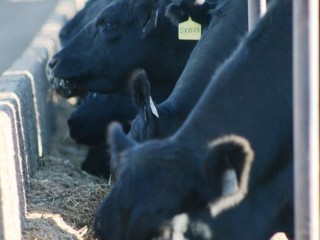 The sums on feeding 100-day grainfed cattle have swung back savagely into negative territory this week, on the back of some big slides in finished cattle value.
The sums on feeding 100-day grainfed cattle have swung back savagely into negative territory this week, on the back of some big slides in finished cattle value.
An analysis based on yesterday’s spot market for inputs suggested a breakeven figure of 375c/kg dressed weight for 100-day grainfed steers ex-Darling Downs, going on feed today and closing-out during week-four in September.
That’s down 10c on a similar analysis done a fortnight ago. The main reason is that feeder steer prices have dropped around 10c/kg liveweight over the past two weeks, easing from 190c to 180c. Finished ration price has also eased $5/t to $265/t.
Total cost calculated was $1316, including feeder steer purchase plus typical feeding program, and a 1pc mortality rate.
The biggest change in cost/price variables overall has been in the over-the-hooks forward market price for late September, which has slumped to the 350s, from the high 370s seen in this same analysis a fortnight ago. It should be pointed out, however, that there is only limited current participation in the forward 100-day market, and the entire 100-day market complex has changed quite dramatically over the past four days.
For example the spot market for 100-day grainfeds today is also around the 350c/kg mark, down from mid 370s just four days ago. That’s due mostly to a backlog of meat in the supply chain, and very flat demand in Japan.
Forward-contracted 100-day product being killed today in some examples cost processors 390c/kg, which represents a vast gulf from current spot price about 40c/kg below that, worth about $120 per beast.
The forward-contract sale price decline means today’s proposition for close-out in 100 days’ time is about 25c/kg dressed weight below breakeven, worth about negative $89 a head. That’s a very long way from the 6-7c deficit between forward price/breakeven seen a fortnight ago (-$25/head).
The calculation is based on assumptions including a 356kg dressed weight, average daily gain of 2kg, and a feed conversion ratio of 7.5:1 (as fed).
Similar calculations made pre-Easter produced a 100-day profit result very close to breakeven.
Breakeven figures like those produced this week do not auger well for the quarterly feedlot activity survey, to be conducted at the end of this month. Compared with the solid outlook just two months ago, there is a lot more bearish sentiment evident around in Australian lotfeeding circles at the moment, and no immediate signs of change in market variables.
Reduced kills by processors to lower the amount of overall beef in the market and narrow the gap between supply and demand is seen as the likely short-term solution by some stakeholders.
One lotfeeder felt it unlikely that feeder steer prices would decline much further. If they did, many breeders would elect to retain cattle on the abundant feed at their disposal and grow the cattle out to grassfed export weights themselves over the next six months. Even getting 10c/kg less than what they can today, given the extra weight, that represents a lot better trade than selling feeders and buying in light restocker cattle.
Numbers up in US feedlots
In the US, meanwhile, feedlot inventories have been notably higher than year-ago levels for much of 2011, in large part reflecting the impact of drought conditions in Texas and surrounding areas.
Also, the steady increase in US cattle futures during the first four months of the year provided an incentive for feedlots to accelerate placements despite high feed costs, according to Len Steiner's Daily Livestock Report.
This pattern is expected to change this northern hemisphere summer, however. In part it would be driven by the sharp rise in feed costs at a time when cattle prices have taken a step back, Mr Steiner said.
"Also, just because the US has more cattle on feed does not mean that there are more cattle available for sale. Rather, market and weather conditions earlier this year accelerated the
pace at which calves came to market, spending less time on pasture and more time in feedlots."
The US calf crop in 2011, which is the number of calves produced in a given year out of the breeding herd, will likely be the smallest in some 50 years, he said.
"Feeder cattle supplies are tight, particularly since the US industry accelerated marketings earlier in the year. While feeder cattle futures have been pressured lower, feeder basis is up significantly, indicative of shortages in some areas."
Market participants expect US feedlot placements in May to be down 7.5pc.
Today’s NLRS Eastern Young Cattle Indicator closed at 381.25c, down 4c on a week ago. The NLRS feeder steer indicator was down 3c for the week to 201.2c.
- Beef Central publishes a fortnightly 100-day grainfed breakeven scenario based on a standard set of production variables (ex Darling Downs). While a representative set of variables has been chosen, it is important to note that variations can exist across production models (FC, daily gain, mortality, morbidity, carcase specification), from feedlot to feedlot, and between mobs of cattle. For a more specific performance forecast on a given mob of cattle, contact your preferred custom feeder.

HAVE YOUR SAY